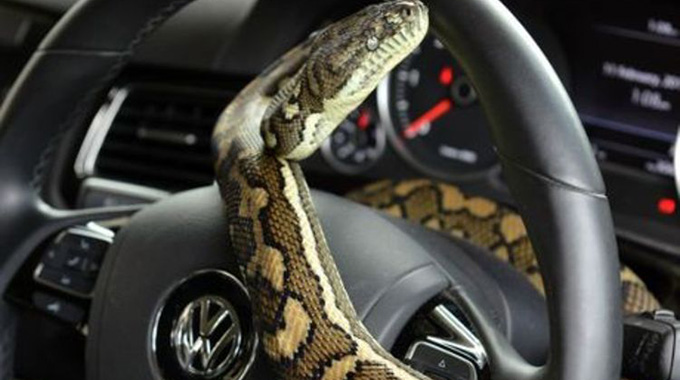When you come across a snake . . .

Isdore Guvamombe
A couple from Borrowdale has returned from a New Year’s Eve outing at Lake Chivero on the outskirts of Harare.

Tired, they lock up the car in the garage and retire for the night.
In the morning, the wife prepares to leave for work and after shaking off the lethargy of sleep, she moves to empty the car cabin of all knick-knack leftovers.
She opens the passenger front door and to her shock, a snake slithers on the dash board, twigging its tongue, head poised.
She instinctively, screams, backs off and bangs the door closed.
Everyone at the house wakes up, gathers around the car, but the snake is nowhere to be seen. Everyone is scared, but the snake has skimmed into hiding.
After some minutes, a brave relative, searches the car and finds nothing.
But everyone is afraid of driving the car and it remains parked for two days.
On the fourth day, the husband sees the snake again, this time on the seat and it moves to the dash board, using the steering as its aide.
A neighbour suggests they place poisoned milk in a plate. The next day the snake is found dead, apparently from drinking the milk.
If dehydrated enough, snakes will drink milk, but if thirsty enough, they will drink just about anything.
Some snakes we find in our homes or rare places will have found their way into our cars and somehow found a place to coil up on until the car stops.
In the lethargy of the travel, they might stay in the car for some days, while trying to recollect themselves, find their lost bearing and decide how to start another life.
On cars, snakes are known to somehow find some little space or pocket to stay.
At times they are found on the engine when it has turned has cooled down.
Cases of snakes being stowaways, unsanctioned hitch-hikers catching up a lift with unsuspecting motorists are common the world over.
But, your first reaction when you come across a snake is very important to what happens next.
Snakes have very poor eyesight, and that is why they twig their forked tongues to sense immediate environs. They don’t have eyelids.
Instead, they have a transparent scale called a spectacle that covers and protects the eye.
Snakes have no eardrums, but possess inner ears able to pick ground vibrations such as footsteps and low frequency air sounds.
They have difficulty with higher pitch sounds, but your footsteps send proper signals that determine a snake’s next action.
Tenderness, compassion and loyalty are all human emotions, even if we don’t seem to see them too much on adults nowadays, and snakes are quick to notice these when you come across them.
This is precisely the reason why toddlers are hardly beaten by snakes when they come face-to-face with them. Snakes hardly identify toddlers as life-threatening. But I am not by any means advocating that toddlers be left to play with snakes. No! Kids and snakes may sometimes think that they can be friends, but that doesn’t mean this type of relationship needs to be encouraged.
On average, an adult will panic, scream, run away or even throw stones and sticks in attack; other snakes try to escape, others turn and fight back with dangerous consequences.
Spitting cobras will spit with precision within two to three metres. Simply stay away. Back off. Simply keep a safe distance from snakes.
Ask National Parks and Wildlife Management Authority for assistance.
Most snakes have no desire to be around people, but life being life, an encounter is unavoidable. And like humans, snakes understand social space. That respectable space is good to avoid conflict. When you come across a snake, give it its space and it will leave.
It is important to remember that snakes are more scared of us than we are of them, and are very unlikely to attack a person if left unprovoked.
Some snake species are not even venomous, and it is important to understand the various types we find in our areas so that it is easier to gauge the threat if you know what species you are dealing with.
In Zimbabwe, there are a lot of venomous snakes, especially the black mamba, puff adders, and cobras which are very common and extremely dangerous.
But there are pythons too, that will give you something like a dog bite, with no venom, but are dangerous when they hunt you for food.
In most cases, even the venomous snakes will not attack unless they feel threatened, so the risk that they actually pose is not as great as many believe.
Sadly, people have this impression that snakes are so dangerous that they need to be killed on sight, rather than being caught by a registered snake catcher to be dealt with humanely.
If you decide to deal with the snake yourself, which is not encouraged, you better be too good.
But always avoid attacking snakes and call for professional help.
Avoid touching snakes. Back off!
Feedback: [email protected]









Comments